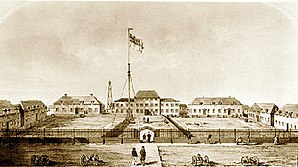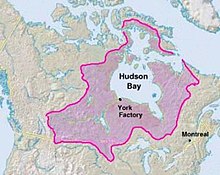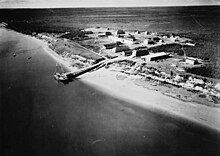York Factory (Manitoba)
| York Factory | ||
|---|---|---|
 York Factory (1853) |
||
| Location in Manitoba | ||
|
|
||
| State : |
|
|
| Province : | Manitoba | |
| Region: | Northern region | |
| Coordinates : | 57 ° 0 ′ N , 92 ° 18 ′ W | |
| York Factory National Historic Site of Canada Lieu historique national du Canada York Factory |
|
|---|---|
|
Historic Place of Canada Lieu patrimonial du Canada |
|
| Recognized since | May 28, 1936 |
| Type | National Historic Site of Canada |
| ID | 4481 |
| Recognized by | Canadian Federal Government |
| Approved by | Historic Sites and Monuments Act |
| Entry Canadian List of Monuments | |
York Factory was a settlement on the southwest coast of Hudson Bay in northeast Manitoba in Canada at the mouth of the Hayes River , about 220 km south-southeast of today's Churchill . York Factory was the headquarters of the Hudson's Bay Company (HBC) in North America until 1957 , but is no longer permanently inhabited.
When it closed, the indigenous community that was closely linked to the fur trade was moved by the government to what would become the York Factory First Nation . HBC's buildings are now owned by the Government of Canada and managed by Parks Canada . Today, no one is resident at the place, the buildings are only used as summer residences for the employees of Parks Canada and there is accommodation for hunters nearby. The wooden buildings were built in 1831 and are the oldest and largest wooden structures in Canada on permafrost ground.
history
From the 17th to the 19th centuries, the place was the base of the fur trade and other business of the HBC with the Indians in Rupert's Land , the huge drainage basin of Hudson Bay, which forms much of what is now Canada.
The first HBC headquarters, Fort Nelson , was built at the mouth of the nearby Nelson River in 1682. The inauguration of the fort provoked a swift reaction from France , which sent its naval forces to Hudson Bay in 1684 to capture and destroy the fort. The company built a second fort on the Hayes River and named it after the Duke of York . In 1697, the largest Arctic naval battle in North American history began when the French captured the fort and renamed it Fort Bourbon . The French forces suffered heavy losses in the sea battle with the three English warships and took the fort with the last of their strength. They achieved victory by successfully creating the appearance of being the stronger force. Fort Nelson was returned to the British in 1713 as part of the Peace of Utrecht . After 1713, the headquarters were moved to the current location at the mouth of the Hayes River.
Between the 1820s and the 1840s, the post was the start and end point of the York Factory Express , a long-distance trade route to Fort Vancouver in the Columbia District .
The former trading post was declared a National Historic Site of Canada on May 28, 1936 .
Web links
Individual evidence
- ^ York Factory National Historic Site of Canada. In: Canadian Register of Historic Places. Retrieved July 27, 2020 (English).


